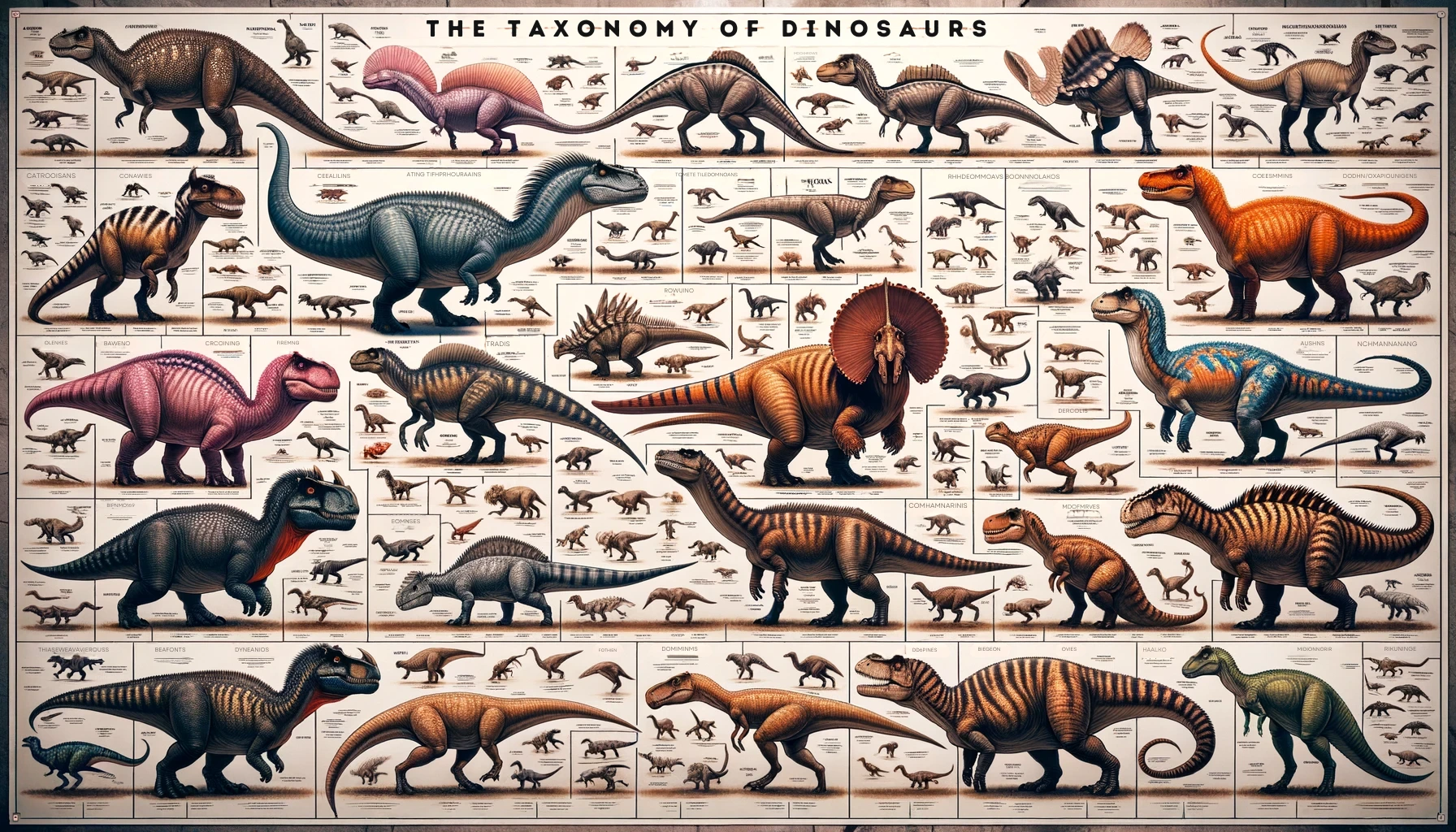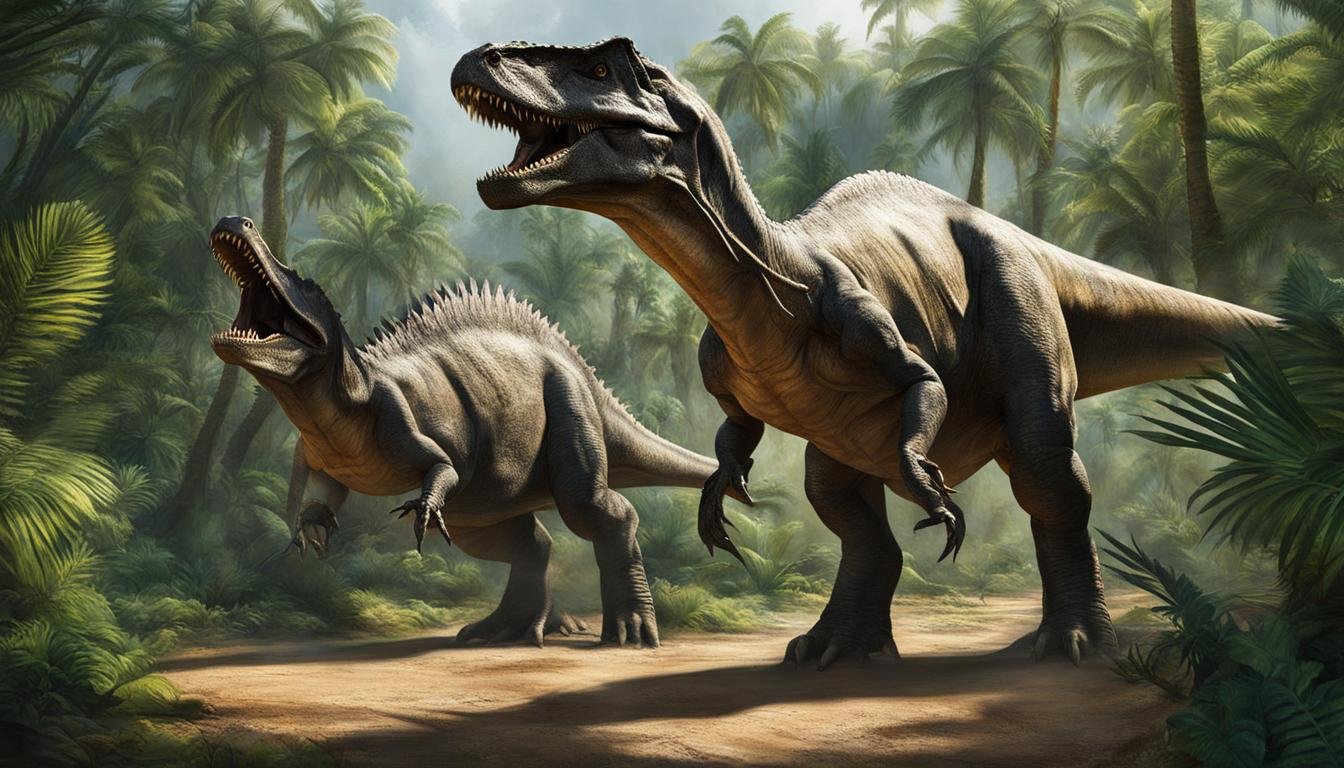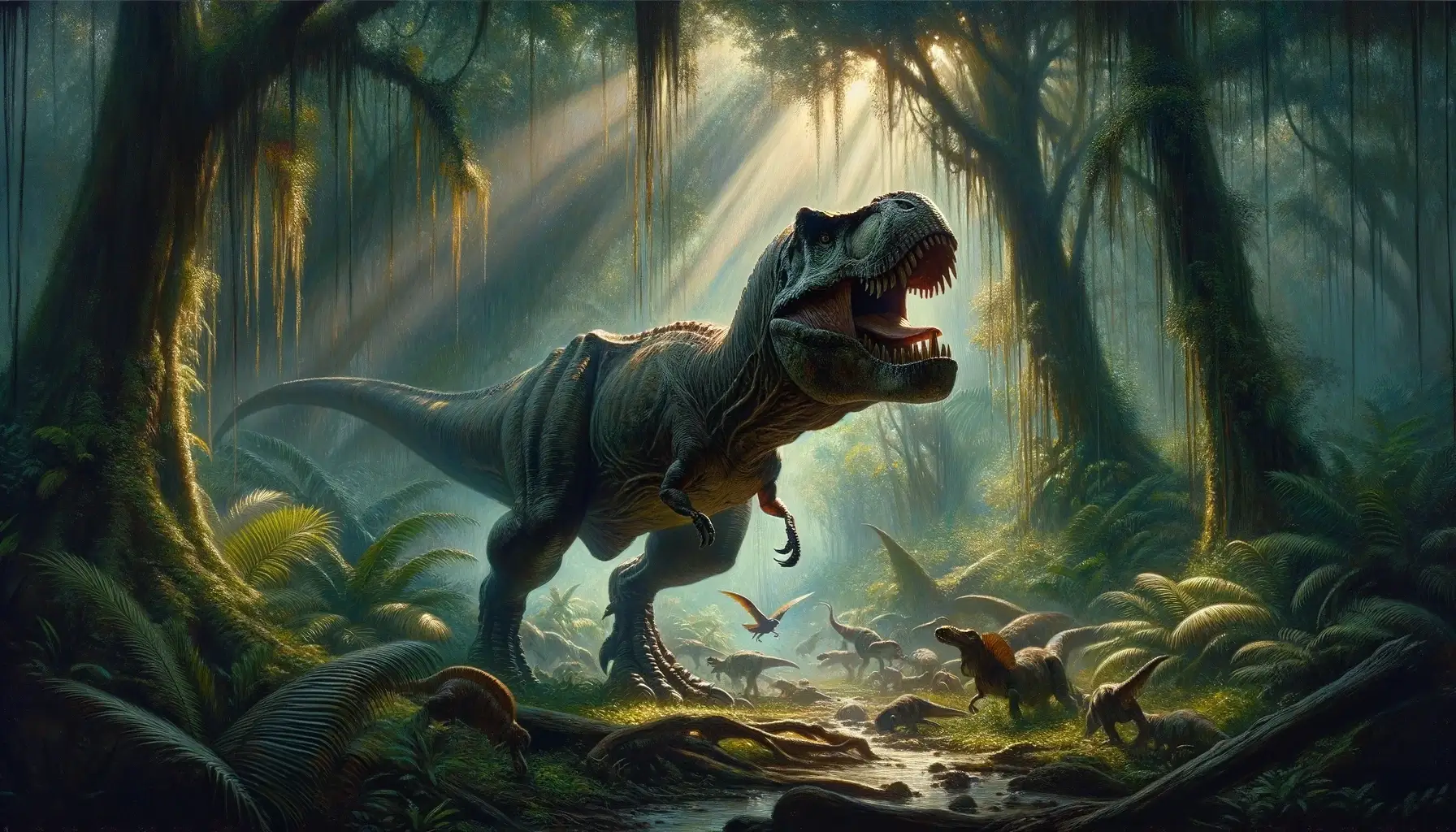Diving into the ancient world of dinosaurs is like opening a book filled with mysteries yet to be solved. Central to unraveling these mysteries is understanding the Basics of Dinosaur Classification, a fascinating venture that sheds light on the myriad forms and families of these prehistoric giants. As we embark on this narrative, we’ll explore the foundational frameworks that have helped shape our knowledge of the dinosaur kingdom, unearthing the secrets that lie within the bones of Earth’s former rulers. Each classification unveils a new chapter in the epic saga of dinosaurs, beckoning us to delve deeper into a world long gone.

Unveiling the Epoch of Dinosaurs
The Mesozoic era, often referred to as the Age of Dinosaurs, was a time in Earth’s history that spanned from about 252 to 66 million years ago. This epoch is divided into three periods: the Triassic, Jurassic, and Cretaceous periods, each of which contributed unique dinosaur species to the vast and varied tapestry of prehistoric life.
During this era, our planet bore witness to an explosion of biological diversity, particularly among the dinosaurs. These majestic and sometimes terrifying creatures roamed across the continents, dominating the land in a way no creatures have managed since.
Understanding the classification of dinosaurs is not merely an academic endeavor. It provides a glimpse into the ancient world, offering insights into evolutionary processes, biological adaptations, and the intricate web of life that spanned Earth’s continents millions of years ago. The classification of dinosaurs helps to organize our understanding of the myriad species that existed, providing a structured approach to studying their similarities, differences, and evolutionary relationships.
Delving Into Dinosaur Taxonomy
Taxonomy, the science of classifying living organisms, plays a crucial role in paleontology. It provides a structured framework within which scientists and researchers can organize and categorize extinct species based on a variety of characteristics.
One of the cornerstones of dinosaur classification is the Linnaean system. Named after Carl Linnaeus, the father of taxonomy, this system categorizes organisms based on morphological characteristics—physical traits and attributes that can be observed and measured.
Definition of Taxonomy and its Importance in Paleontology
Taxonomy is more than just a naming convention. It’s a tool that paleontologists use to unravel the evolutionary lineage of dinosaurs, understanding their relationships with other organisms, both extinct and extant. By classifying dinosaurs into meaningful groups based on shared characteristics, researchers can make more accurate predictions about unknown or poorly understood species, based on what is known about their close relatives.
Furthermore, a solid grasp of taxonomy is essential for communicating findings within the scientific community and to the public. It enables paleontologists to present their discoveries in a structured, organized manner, making it easier for others to understand the significance of their work.
Overview of the Linnaean System: The Cornerstone of Dinosaur Classification

The Linnaean system of classification is hierarchical, organizing species into nested categories, from general to specific: Kingdom, Phylum, Class, Order, Family, Genus, and Species, often abbreviated as KPCOFGS.
Here’s a simplified example of how this system might apply to a well-known dinosaur, Tyrannosaurus rex:
- Kingdom: Animalia
- Phylum: Chordata
- Class: Reptilia
- Order: Saurischia
- Family: Tyrannosauridae
- Genus: Tyrannosaurus
- Species: T. rex
In paleontology, this system aids in distinguishing between different dinosaur species and understanding the evolutionary relationships between them. For instance, the order Saurischia includes all “lizard-hipped” dinosaurs, a group that is further subdivided into families and genera based on other morphological traits.
Through the lens of the Linnaean system, the enigmatic world of dinosaurs transforms into an organized, comprehensible structure, opening doors to deeper understanding and exploration of the prehistoric world that once was.
The Fundamental Classifications of Dinosaurs
Venturing into the realm of dinosaur classification unveils a fascinating network of categories and sub-categories that help us understand the many diverse species that once roamed our planet. These classifications, anchored in anatomy and physiology, offer a lens through which we can explore the profound diversity and evolutionary adaptation of dinosaurs.
By Locomotion and Posture
One of the primary classifications of dinosaurs is based on their locomotion and posture. These characteristics provide significant insight into their daily lives, hunting or grazing habits, and their interaction with the environment.

Bipedal versus Quadrupedal Dinosaurs: A Comparative Glance
Dinosaurs are often classified based on their stance and the number of legs they used for locomotion.
- Bipedal Dinosaurs:
- Dinosaurs like the Tyrannosaurus Rex and Velociraptor moved on two legs, a posture that often suggests a carnivorous diet and a potentially active predatory lifestyle.
- Bipedalism allowed for greater speed and agility, crucial for hunting prey.
- Quadrupedal Dinosaurs:
- On the other side, dinosaurs such as Triceratops and Brachiosaurus were quadrupeds, utilizing all four limbs for locomotion.
- This posture provided stability and supported the weight of larger, often herbivorous, dinosaurs.
| Locomotion Type | Typical Characteristics | Examples | Dietary Habits | Advantages |
|---|---|---|---|---|
| Bipedal | Greater speed and agility | Tyrannosaurus Rex, Velociraptor | Often carnivorous due to active predatory lifestyle | Enhanced speed for hunting prey |
| Quadrupedal | Stability and support for larger body weight | Triceratops, Brachiosaurus | Often herbivorous | Stability and support for carrying larger weight |
Erect Versus Sprawling Posture: Unveiling the Nuances
The posture of dinosaurs also played a significant role in their classification.
- Erect Posture:
- Dinosaurs with an erect posture held their limbs directly beneath their bodies.
- This posture allowed for more efficient locomotion over longer distances and is typically seen in dinosaurs that were more active or had larger territories.
- Sprawling Posture:
- Conversely, a sprawling posture, where the limbs are spread out from the body, is often associated with a more sedentary lifestyle or smaller territories.
By Hip Structure
The hip structure is another pivotal classification criterion, drawing a line between two major groups of dinosaurs based on the configuration of their pelvic bones.
Saurischian (Lizard-Hipped) Dinosaurs: A Closer Look
- Characteristics:
- Saurischian dinosaurs have a pelvic structure more reminiscent of modern-day lizards, with a pubis bone oriented forward.
- This group includes both carnivorous dinosaurs like Tyrannosaurus and herbivorous giants like Brachiosaurus.
- Evolutionary Significance:
- The saurischian hip structure is believed to be the ancestral condition for all dinosaurs, making it a critical aspect of dinosaur evolution.
Ornithischian (Bird-Hipped) Dinosaurs: Distinguishing Features
- Characteristics:
- Contrary to what the name might suggest, bird-hipped dinosaurs have a pelvic structure that is actually quite different from modern birds.
- In ornithischians, the pubis bone is oriented backward, parallel with the ischium, creating a more bird-like appearance.
- Evolutionary Significance:
- Despite the bird-like hip structure, it’s the lizard-hipped dinosaurs that are believed to be the ancestors of modern birds, showcasing an intriguing evolutionary twist.
The voyage through the basics of dinosaur classification unearths a compelling narrative of evolution, adaptation, and the intricate interplay of form and function that governed the lives of these awe-inspiring prehistoric creatures. The categorization based on locomotion, posture, and hip structure lays a solid foundation, paving the way for a deeper understanding of the dinosaur lineage and their place in Earth’s evolutionary tale.
An In-depth Examination of Dinosaur Orders and Families
As we delve deeper into the vast realm of dinosaur classification, we traverse through various orders and families, each boasting unique traits and evolutionary marvels. This section aims to illuminate the distinguishing features of different dinosaur groups, offering a glimpse into their diverse lifestyles and ecological roles during the Mesozoic Era.
Theropods: The Flesh-Eaters
The realm of theropods unveils a world where sharp claws and voracious appetites reigned supreme. These bipedal carnivores are some of the most iconic and fearsome dinosaurs to have ever roamed the Earth.
Unveiling the Characteristics and Sub-families of Theropods
- Physical Traits:
- Generally, theropods were characterized by their hollow bones and three-toed limbs, adaptations that contributed to their agility and predatory prowess.
- Size among theropods varied greatly, from the diminutive Compsognathus, measuring a mere 1 meter (3.3 feet) in length, to the gargantuan Tyrannosaurus Rex, stretching up to 12 meters (39.4 feet) from snout to tail.
- Sub-families:
- Theropods are subdivided into numerous sub-families like Tyrannosauridae, Velociraptorinae, and Allosauridae, each with unique traits and evolutionary adaptations.
Discussing Notable Theropods: T-Rex and Velociraptors
- Tyrannosaurus Rex:
- T-Rex, a member of the Tyrannosauridae family, is perhaps the most iconic dinosaur, known for its massive size, powerful jaws, and fearsome reputation.
- With an estimated weight of around 8,000 kilograms (8 tons), T-Rex was one of the largest land predators to have ever existed.
- Velociraptors:
- Velociraptors, on the other hand, were smaller but no less terrifying. Belonging to the Velociraptorinae sub-family, these agile predators were likely very intelligent, using their sharp claws and wits to catch prey.
Sauropodomorphs: The Long-Necked Giants
The Sauropodomorphs were the gentle giants of the dinosaur world, known for their enormous size and long necks which they used to reach vegetation other dinosaurs couldn’t.
Identifying the Hallmarks of Sauropodomorphs
- Physical Traits:
- Characterized by their long necks, long tails, and four thick, pillar-like legs, sauropodomorphs were quintessential herbivores, browsing on the foliage of high trees.
- Size and Scale:
- Some sauropodomorphs were among the largest creatures to have ever walked the Earth, with species like Argentinosaurus measuring up to 35 meters (115 feet) in length.
Exploring Notable Families: Brachiosauridae and Diplodocidae
- Brachiosauridae:
- Dinosaurs in this family, such as Brachiosaurus, were known for their exceptionally long necks and relatively short, stout bodies.
- Diplodocidae:
- Diplodocids like Diplodocus and Apatosaurus had extraordinarily long tails and necks, but with a more elongated body compared to brachiosaurs.
Ornithopods: The Bird-Footed Dinosaurs
Ornithopods were a diverse group of herbivorous dinosaurs known for their bird-like feet and adaptive versatility.
Characteristics and Evolutionary Significance of Ornithopods
- Physical Traits:
- Ornithopods featured a beak-like structure for cropping plants, and many had complex dental batteries for grinding vegetation.
- Evolutionary Journey:
- Their evolution saw a transition from bipedal to quadrupedal locomotion, allowing them to adapt to varying ecological niches.
Delving into Notable Families: Hadrosauridae and Iguanodontidae
- Hadrosauridae:
- Often termed as “duck-billed dinosaurs” due to their broad, flat snouts, hadrosaurs showcased an impressive array of cranial ornamentation and are known for their sophisticated dental batteries.
- Iguanodontidae:
- Iguanodontids were among the earliest ornithopods, and their name – meaning “Iguana-tooth” – reflects the similarity of their teeth to those of modern iguanas.
The Modern Impact of Dinosaur Classification
The quest to classify dinosaurs isn’t merely a historical endeavor, but a dynamic discourse that bridges the prehistoric past with modern-day scientific inquiries. The influence of dinosaur classification extends beyond the paleontological sphere, enriching our understanding of avian evolution, and continually shaping research methodologies in paleontology.
Implications on Avian Evolution
The avian lineage holds a profound connection to the prehistoric world of dinosaurs, a link that’s intricately unveiled through the meticulous art of classification.
Unveiling the Connection Between Birds and Dinosaurs
The consensus within the scientific community is clear: birds are living dinosaurs. This extraordinary connection was established through the classification of certain dinosaurs that showcased avian-like features. The theropod group of dinosaurs, particularly the sub-group known as Maniraptora, shares a remarkable number of traits with modern birds.
- Feathered Dinosaurs:
- The discovery of feathered dinosaurs like Archaeopteryx and Microraptor was a watershed moment, providing tangible evidence of the link between birds and dinosaurs.
- Anatomical Similarities:
- The skeletal structure, particularly the structure of the hip and the wrist, showcases striking similarities between some theropod dinosaurs and birds.
Discussing the Role of Classification in Tracing Avian Evolution
Classification has been instrumental in tracing the evolutionary pathway from dinosaurs to birds.
- Taxonomical Analysis:
- By classifying dinosaurs based on morphological traits, scientists can identify the evolutionary changes that led to the development of flight and other avian characteristics.
- Phylogenetic Trees:
- Dinosaur classification aids in the construction of phylogenetic trees, visual representations of the evolutionary relationships between different species, which are crucial for understanding avian evolution.
Influencing Paleontological Research
The classification of dinosaurs is not a static field; it’s a dynamic, evolving discourse that continually shapes the trajectory of paleontological research.
How Classification Aids in Paleontological Discoveries and Research
- Identifying New Species:
- The systematic classification of dinosaurs provides a structured framework that assists paleontologists in identifying new species based on established taxonomic groups.
- Comparative Analysis:
- Classification enables comparative analysis across different dinosaur taxa, allowing researchers to identify evolutionary trends and morphological variations.
The Role of Dinosaur Classification in Understanding Prehistoric Ecosystems
- Ecological Niches:
- By examining the classification of dinosaurs, researchers can infer the ecological niches various dinosaurs occupied, shedding light on the prehistoric ecosystems.
- Extinction Events:
- Understanding how different dinosaur classes and families diversified or went extinct over time can provide insights into the larger paleoecological events of the Mesozoic era.
Exploring the Future of Dinosaur Classification
The journey through the annals of dinosaur classification does not halt at the historical or the contemporary. It propels forward into the intriguing realm of future possibilities. The fusion of technology and molecular analysis, along with the continuous thirst for knowledge, paves the way for an exciting horizon in the sphere of dinosaur classification. As we venture into this uncharted territory, we might stumble upon new taxonomic categories that could redefine our understanding of these magnificent prehistoric creatures.
The Role of Technology and Molecular Analysis
In the quest to delve deeper into the intricacies of dinosaur classification, technology emerges as a powerful ally. The advent of molecular analysis, particularly DNA analysis, has unfurled a new dimension in understanding the lineage and relationships among dinosaurs.
Discussing the Impact of DNA Analysis and Other Technological Advancements on Dinosaur Classification
- DNA Analysis:
- Although the chances are slim, the potential discovery of dinosaur DNA could revolutionize dinosaur classification. By analyzing genetic material, scientists could determine relationships among dinosaur species with a precision hitherto unattainable.
- CT Scanning and 3D Imaging:
- Modern imaging technologies such as CT scanning and 3D imaging have already begun to reshape dinosaur classification. These tools allow paleontologists to peek inside fossilized bones and eggs, unveiling hidden anatomical structures and embryonic remains that can provide invaluable insights into dinosaur development and taxonomy.
- Machine Learning and AI:
- Machine learning algorithms and artificial intelligence (AI) hold the promise of aiding the classification process. By analyzing vast datasets of morphological characteristics, these technologies can help identify patterns and relationships that might be too complex for human analysis.
Emergence of New Taxonomic Categories
As the veil of prehistory gradually lifts with every technological advancement, it’s plausible to speculate about the emergence of new taxonomic categories that could further enrich the landscape of dinosaur classification.
Speculating on the Future: Are There Undiscovered Classifications?
- Potential New Orders or Families:
- The discovery of new dinosaur fossils, especially from poorly sampled regions or geological formations, could lead to the identification of entirely new orders or families. Each new discovery has the potential to challenge existing classifications and prompt re-evaluations of dinosaur phylogeny.
- Integration of Genetic and Morphological Data:
- In a futuristic scenario where genetic data from dinosaurs becomes available, integrating this data with traditional morphological analysis could lead to a more nuanced and robust dinosaur classification system.
- Global Collaborations and Data Sharing:
- The future of dinosaur classification may also be influenced by global collaborations and data sharing among paleontologists. Open access to a wealth of global data could foster the development of a more holistic and unified classification system.
The horizon of dinosaur classification is expansive and full of promise. With each stride in technological innovation and each new fossil unearthed from the bosom of the Earth, we inch closer to a more nuanced understanding of the prehistoric titans that once roamed our planet. The future beckons with the allure of unexplored territories in the domain of dinosaur classification, heralding a continued era of discovery and enlightenment.
FAQ
What is the importance of dinosaur classification?
Dinosaur classification helps scientists and researchers organize and understand the relationships between different species. It provides a structured framework to study the evolution, behavior, and extinction of dinosaurs, acting as a linchpin for paleontological research.
How are dinosaurs classified?
Dinosaurs are primarily classified based on their physical characteristics, such as bone structures, hip design, and locomotion. The broader categorization divides dinosaurs into two groups: Saurischia (lizard-hipped) and Ornithischia (bird-hipped), which are further subdivided into various families and genera.
What are the main groups of dinosaurs?
The main groups of dinosaurs include Theropods (carnivorous dinosaurs), Sauropodomorphs (long-necked herbivores), and Ornithopods (bird-footed herbivores). Each of these groups is diversified into numerous families and species with distinct characteristics.
How has technology impacted dinosaur classification?
Modern technology, including CT scanning, 3D imaging, and potentially DNA analysis, has significantly impacted dinosaur classification. These technologies allow for more precise analysis of fossils, aiding in the identification of new species and the re-evaluation of existing classifications.
Are there still undiscovered dinosaur classifications?
It’s highly likely that there are undiscovered dinosaur classifications awaiting discovery. As new fossils are unearthed and technology advances, the potential to identify new species and redefine existing classifications continues to grow.
What role does DNA analysis play in dinosaur classification?
While the preservation of dinosaur DNA is extremely rare, any potential discovery could revolutionize dinosaur classification. DNA analysis could provide unparalleled insights into the evolutionary relationships between different dinosaur species.
How does the classification of dinosaurs contribute to our understanding of avian evolution?
The classification of certain dinosaurs, especially theropods, has been instrumental in establishing the evolutionary link between dinosaurs and birds. It aids in tracing the lineage and understanding the morphological transitions that led to the advent of avian species.
How do paleontologists determine the classification of a newly discovered dinosaur?
Paleontologists utilize a combination of morphological analysis, comparative anatomy, and often, cladistic analysis to determine the classification of a newly discovered dinosaur. They compare the anatomical features of the new specimen with those of previously known dinosaurs to ascertain its position in the dinosaur family tree.
Is dinosaur classification a static or evolving field?
Dinosaur classification is an evolving field. With each new discovery and the advent of modern technologies, classifications may be revised or new categories introduced to accommodate a deeper understanding of dinosaur evolution and relationships.
How can I learn more about dinosaur classification?
There are numerous resources available for those keen on exploring dinosaur classification further. Reputable paleontology books, academic papers, museum exhibits, and educational websites are excellent avenues to delve deeper into this captivating subject.








